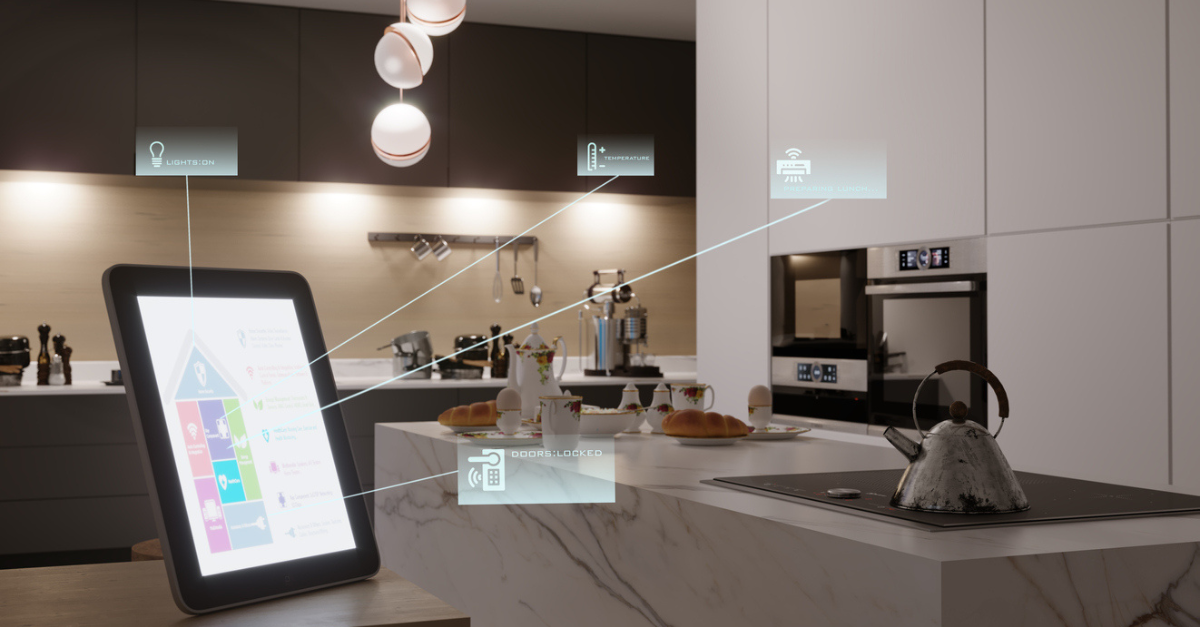Smart home IoT is rapidly increasing, with connectivity and intelligence embedded in lighting, temperature, irrigation controls, appliances, energy management, etc. These smart devices and applications enable greater comfort, efficiency, and safety. Smart home hardware shipments are estimated to grow by 9.4% and reach more than 1.7 billion devices by 2030.
GlobalSign, in partnership with ABI Research, has extensively examined the accelerating evolution of smart home devices and applications, highlighting significant developments and echoing the need for tighter security measures.
Smart Home Network Architecture Matters
Smart home IoT network architecture is expanding in large part due to Matter. The Matter 1.0 specification is a universal IPv6-based communication protocol. Regardless of the manufacturer, it facilitates interoperability and communication between smart home devices such as thermostats, HVAC, lights, door locks, etc. Matter is expected to be integrated into billions of smart home devices by 2030. In the Matter ecosystem, a Thread border router creates a low-power and low-latency mesh network designed specifically for smart home IoT. It routes communication from within that network to other external networks. Thread border routers can be built into any smart home device with an always-on connection to the main power. Because of Matter, more smart home manufacturers are expected to add Thread border routers to their devices.
As these technologies impact other key areas of life like healthcare, energy, mobility, insurance, retail, and entertainment, consumers will need assurance that these functions can be trusted with their personal data.
Software developers and service providers must heed emerging policies and regulations for their commercial offerings. The U.S. National Cybersecurity Strategy, published in March 2023, sets out two key strategic objectives that will impact the smart home sector. First, the IoT security labeling of products, which will create marketplace incentives for those products that comply. Secondly, legislation will increasingly shift liability for insecure software products and services onto software developers and service providers. This objective aligns with similar legislation in Europe through the Cyber Resiliency Act of 2022, requiring assurance of product security at the design phase and throughout the product’s lifecycle.
How Have Smart Home Applications Evolved?
In GlobalSign and ABI’s whitepaper, a number of key use cases are highlighted, and showcases growth areas for smart technology within the home are evolving and gaining momentum at an astounding pace.

-
Physical Security - Security devices such as smart motion sensors, doorbells, wireless cameras, and smart locks boost personal safety. However, these devices lack support in the case of a security breach. Alternatively, smart home services can more effectively protect devices through network security.
-
Energy Management – Connectivity within home equipment and appliances like water heaters, furnaces, and EV charging systems. More than 140 million smart thermostats have been installed worldwide, with significant growth expected. Eventually, whole-home unified energy management systems will detect device vulnerabilities and impairments with access and control lock-down capabilities to mitigate risk.
-
Mobility - Interconnectivity and AI-enabled apps will enable monitoring for efficient EV charging times and where to pull energy. Smart systems will also pull data from outside for weather and road conditions, destination information, service availability, etc.
-
Healthcare - Spending on services such as Home Monitoring, Remote Patient Monitoring, and Social Robotics is expected to multiply by a factor of nine by 2030. Ambient Assisted Living (AAL) applications that use similar smart sensors and connectivity options will certainly expand. Due to the sensitive nature of healthcare data, regulatory compliance will heighten to enforce greater security measures.
-
Home Appliances – Smart home IoT interoperability is a key trend. Matter with embedded Thread routers enables the integration of most smart home appliances under a common application messaging framework for simple cross-platform communication.
-
Smart Home Network Architectures – The smart home network will depend upon multifunction gateway devices to low-power devices to the home system and the cloud. Border routing and connectivity will increasingly be embedded in more devices, and more intelligence and data will be generated throughout the smart home system. As a result, consumers will require new levels of shared trust, security, and responsibility.
Security Challenges for Smart Home IoT Devices
Smart home IoT devices needs security protections that ensure safety from malicious actors, as well as misconfigurations and errors that accidentally expose data. Regulations mandating both the privacy and security of devices are expanding globally (i.e., EU Cyber Resilience Act, GDPR, and U.S. IoT Cybersecurity Improvement Act), driving security integration in smart home ecosystems.
Key areas of security focus:
-
Device identity and root of trust
-
Authenticity of firmware/software
-
Data integrity
-
Communication security
Device identities, facilitated through certificates from trusted certificate authorities, are key enablers for data security, privacy, and secure communications. Matter 1.0 has device identity requirements and all communications must be authenticated and encrypted to mitigate attack risks.
The Importance of Identity Within Smart Home IoT
It’s clear within the whitepaper that the importance of identity, in the form of digital certificates and Public Key Infrastructure (PKI), within smart home IoT allows all types of identified devices to connect securely from any location to any other device. PKI offers many flexible options for certificate provisioning and enrollment, deployment, and management (e.g., REST API, SCEP, EST, CMP, CMC, and ACME). PKI technologies are expected to adapt well within the smart home ecosystem.
Digital certificates and PKI benefits include:
-
Enables product differentiation
-
Prevents fraud
-
Increases visibility and attack reduction
-
Ensures reputable smart home brands and increased trust
GlobalSign’s high-scale PKI and identity solutions offer the safety and security of a trusted certificate authority (CA), delivering the scalability, configurability, automation, and compliance needed to protect emerging smart home IoT environments.
For more insights on this topic, read our comprehensive whitepaper Smart Home IoT Devices Need Secure Network Architecture.







